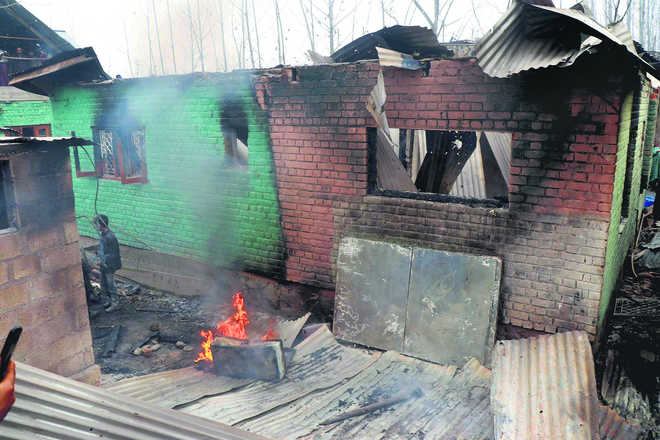
Paradise lost: A boy walks near his house damaged during a gun battle with militants in Bandipora in December.
Azhar Qadri
In the summer of 2018, two days after New Delhi ended its unilateral ceasefire and directed the security forces to resume counter-insurgency operations in Kashmir, the BJP undid its three-year-old alliance with the PDP. Mehbooba Mufti was unseated after a three-year alliance.
The June 19 announcement by Ram Madhav, the BJP general secretary who was instrumental in forming the 2015 alliance, was terse. “It has become untenable,” Madhav told reporters in New Delhi, “for the BJP to continue with the alliance government in Jammu and Kashmir.”
Mufti, whose party had partnered with the BJP after campaigning against it during the elections, was attending a meeting at her office when the announcement was made and televised live.
In an era of growing political and religious polarisation in the country, the alliance between the parties with rivalling political interests was a parallel reality. The BJP, a right-wing national party whose politics focuses on a radical Hindutva agenda, had joined hands with the PDP, a Kashmir-based party that espouses a soft-separatist politics and often jumps the line that distinguishes pro-India from anti-India politics. The pact was then defined as the coming together of the south pole and the north pole.
Mufti Mohammad Sayeed, the then chief of PDP who had confirmed the alliance after meeting Prime Minister Narendra Modi, had referenced to a magnet’s opposite sides to highlight the importance of an unprecedented political moment.
The BJP-PDP alliance, however, had an unceremonious end. All explanations fell short in describing the falling apart of the only alliance which moderated the radical political aspirations of the two parties.
The end of the alliance came at a time when the poorly armed, yet intensely popular militant movement, was battling for resurgence across the Valley. Mainstream politics too had been restricted to the heavily-guarded party offices in Srinagar.
Despite a month-long ceasefire by the security forces, the death of more than 240 militants was a record number and highest in the past decade. However, it served as little deterrence for the steady flow of local recruits, some of them teenagers, some highly educated.
This year the influence of the militants and sympathies for them remained high in the Valley, mainly in the volatile districts of south Kashmir. Several counter-insurgency operations also resulted in a high number of militant deaths and civilian causalities as residents clashed with the security forces in desperate bids to shield militants, the latest being on December 15.
Seven civilians were killed during protests that had followed a gunfight between a group of three militants and security forces in south Kashmir’s Pulwama district, an incident that shocked politicians across the divide.
The casualties in the local police also peaked this year as they came into the crosshairs of militants. Forty-three cops, some of them at home on leave, were killed.
August was the bloodiest month for the cops as eight policemen were killed in militant attacks. The months after the Ramzan ceasefire made for the bloodiest quarter of the year with 15 fatalities.
Counter-insurgencys ops — the new norm
April 1 marked one of the bloodiest days in the recent years as 12 local militants, four civilians and three soldiers were killed in two separate counter-insurgency operations in the volatile Shopian district. The twin gunfights in Shopian came in the backdrop of the rising number of militants in the region. In recent times, the low number of militants in the area has not been able to bargain for renewed logistical support from Pakistan and has mainly relied on weapons snatched from security forces. In the months that followed, counter-insurgency operations, which resulted in unusually high number of militant casualties, became a new norm.
Ramzan ceasefire
Union Home Minister Rajnath Singh announced a unilateral cessation of counter-insurgency operations during the Muslim fasting month of Ramzan in May. This was a replica of an initiative previously launched by Atal Bihari Vajpayee during his tenure as Prime Minister in 2000. The ceasefire was announced following a request by CM Mehbooba Mufti. The announcement was made immediately after she chaired an all-party meeting in Srinagar. The ceasefire, however, was unheeded by militant groups that continued to carry out attacks against the security forces.
Change of guard
Satya Pal Malik was sworn-in as the 13th Governor of Jammu and Kashmir in August. He was administered the oath of office by Chief Justice of Jammu and Kashmir High Court Gita Mittal at the Raj Bhavan. Malik succeeded N N Vohra, who served as the state’s Governor for 10 years since taking over his first term on June 25, 2008 and second term April 28, 2013. Vohra had guided the state through several tumultuous periods, including the protests of 2008, 2010 and 2016, and floods of 2014.
In the news
Journalist shot dead
Shujaat Bukhari, a renowned journalist and editor of local daily, Rising Kashmir, was shot dead by unidentified gunmen in a brazen attack outside his office in Srinagar in June. The killing sent shockwaves across the Valley and militant groups distanced themselves from the attack. The police said attackers were members of Lashkar-e-Toiba. Bukhari was an important man in Track-II initiatives.
A nation shamed
Body of an eight-year-old nomad Bakherwal community girl was recovered from Rassana forest on January 17, a week after she went missing while grazing horses in the forest area. The girl was held captive inside a temple, gangraped, kept without food and administered sedatives. The main accused in the case were Sanji Ram, priest of the temple where the incident took place, his son and nephew.



























